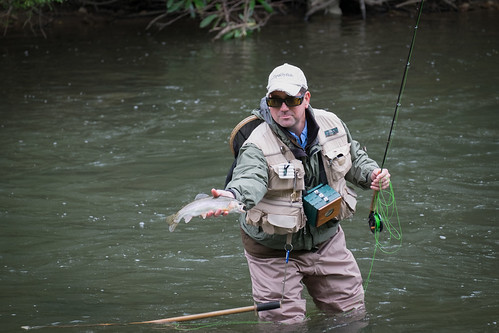You are using an out of date browser. It may not display this or other websites correctly.
You should upgrade or use an alternative browser.
You should upgrade or use an alternative browser.
afishinado
Blue Liner Flows Review | USGS Stream Gauges
Jun 18
- 267
- 2
All water level data originates from the United States Geological Survey (USGS) Surface-Water Data, which monitors over 13,000 stream gauges across the U.S. and more than 350 in Pennsylvania. The USGS has been transitioning to a new online interface over the past five-plus years. The updated look and feel have left some old features behind while adding new ones. I hate it.
So, I’ve been on the hunt for a desktop and mobile app that delivers USGS backend data through a clean, easy-to-use interface. Blue Liner Flows offers a solid solution for iPhone, iPad and Mac users, with apps built for both platforms. Most importantly, favorites and preferences sync across devices. There’s a free version, but I’ll be reviewing the $6.99 annual paid version.
Key features include: favorites, state selection, map view, latest data overview, discharge in CFS, discharge in feet, average annual discharge, various time views, weather forecasts, alerts, temperatures (station-dependent), turbidity (station-dependent), and other data specific to each gauge.
I found the app very easy to set up on my Mac. Once configured, all my favorites and alerts synced automatically to my iPhone. You don’t need both devices—an iPhone alone works just fine. I especially liked navigating between the state, favorites, and map views. It’s fast and intuitive. Most views display the key information I’m looking for, including directional arrows indicating whether water levels are rising or falling.
[ATTACH type="full" width="720px"...
Tying and Fishing Midges
Apr 15
- 4,319
- 2
Many times the rising fish you see in the winter are taking midges. I’ve done well in the winter fishing midges on warmer afternoons. It’s great covering rising fish fish in the winter since I become tired of dredging the bottom, doing the chuck-and-chance-it to unseen fish. I could never stand watching fish rise in front of me without giving them a try.

Tying Midges
Midges are not hard to tie. I use a small sized emerger hook which is a wide gape 2x short curved hook. For dries, just add a thread body and a few fibers for wings or a wisp of dubbing for pupa:
Hook: Emerger hook size 20-28
Body: Thread (black, cream, brown, white, olive) to match naturals. I always try to catch a few insects with my net before I select a fly. If I can't capture a natural, I'll usually try black first.
Wing: 8-12 CDC fibers, or Z-lon, or Antron yarn.
I like to use 6/0 or 8/0 thread for the body depending on the brand of thread and the size of the fly. The body should remain thin like the natural.
Start the thread on the shank behind the eye and wrap it back to the bend. Spin the bobbin to wind the thread tightly by spinning and wrap the thread back to just behind the eye. The tightly wound thread gives a segmented appearance and makes it easier to wrap. On a size smaller fly hook, one pass back and forth is enough to build the body. On larger flies several passes may be needed.
I tie off the heavier thread with finer 12/0 thread to finish the fly. Cut 8-12 CDC fibers (Z-lon or Antron yarn also work) and tie in on top of the hook shank and trim the wing fibers slightly shorter than the body and whip finish. That’s it!...a thread body with some wisps of CDC or yarn for the wing. On larger sized midges I sometimes use a little dubbing the same color as the body to finish off the head.
Don’t make the wings too heavy...

Tying Midges
Midges are not hard to tie. I use a small sized emerger hook which is a wide gape 2x short curved hook. For dries, just add a thread body and a few fibers for wings or a wisp of dubbing for pupa:
Hook: Emerger hook size 20-28
Body: Thread (black, cream, brown, white, olive) to match naturals. I always try to catch a few insects with my net before I select a fly. If I can't capture a natural, I'll usually try black first.
Wing: 8-12 CDC fibers, or Z-lon, or Antron yarn.
I like to use 6/0 or 8/0 thread for the body depending on the brand of thread and the size of the fly. The body should remain thin like the natural.
Start the thread on the shank behind the eye and wrap it back to the bend. Spin the bobbin to wind the thread tightly by spinning and wrap the thread back to just behind the eye. The tightly wound thread gives a segmented appearance and makes it easier to wrap. On a size smaller fly hook, one pass back and forth is enough to build the body. On larger flies several passes may be needed.
I tie off the heavier thread with finer 12/0 thread to finish the fly. Cut 8-12 CDC fibers (Z-lon or Antron yarn also work) and tie in on top of the hook shank and trim the wing fibers slightly shorter than the body and whip finish. That’s it!...a thread body with some wisps of CDC or yarn for the wing. On larger sized midges I sometimes use a little dubbing the same color as the body to finish off the head.
Don’t make the wings too heavy...
Your approach to a day of fly fishing?
Nov 26
- 979
- 0
There are quite a few beginners on the board so I thought I would post a little on how I approach a day on the stream. I would be very interested to read about how others on the board approach a day of Fly Fishing.
The success or failure of a day on the stream (although no day on the stream is really a failure…unless you drown I guess) is often determined before you even leave home. I check flows and temps on the USGS; conditions can differ in certain areas and streams. For example, if the water is high or low, perhaps a more stable stream like a limestoner would be a better choice. I also check the weather and find out the temperature high and low, cloud cover or sun, and rainfall info. I include all this info to make my decision on where to fish.
In addition, If I’m planning to fish an ATW, I will check of the PFBC site for stocking info. Actually, I’m not really a white truck chaser, quite the opposite. I try to avoid freshly stocked fish because I hate the crowds they attract, and I really don’t like fishing for freshly stocked fish, but that’s just me. Some may even use the Internet to find some hotspots (believe it or not!). IMO, posting a good report about a certain stream does attract anglers, especially in the short term. Again, I often do the opposite, if the word is out on hot fishing on a certain stream, I’ll often try to guess where the least amount of pressure is, and choose accordingly. Hatch info on the Internet is useful though. Even if the reports are from a different stream, I can “interpolate” and guess what’s hatching on some streams I know.
Once I pick where I want to fish, if it’s not an all-day trip, my next decision is when to fish; morning, afternoon or evening? As a general rule, in the winter the warmest time of day (afternoon) is usually the best, and in the summer...
The success or failure of a day on the stream (although no day on the stream is really a failure…unless you drown I guess) is often determined before you even leave home. I check flows and temps on the USGS; conditions can differ in certain areas and streams. For example, if the water is high or low, perhaps a more stable stream like a limestoner would be a better choice. I also check the weather and find out the temperature high and low, cloud cover or sun, and rainfall info. I include all this info to make my decision on where to fish.
In addition, If I’m planning to fish an ATW, I will check of the PFBC site for stocking info. Actually, I’m not really a white truck chaser, quite the opposite. I try to avoid freshly stocked fish because I hate the crowds they attract, and I really don’t like fishing for freshly stocked fish, but that’s just me. Some may even use the Internet to find some hotspots (believe it or not!). IMO, posting a good report about a certain stream does attract anglers, especially in the short term. Again, I often do the opposite, if the word is out on hot fishing on a certain stream, I’ll often try to guess where the least amount of pressure is, and choose accordingly. Hatch info on the Internet is useful though. Even if the reports are from a different stream, I can “interpolate” and guess what’s hatching on some streams I know.
Once I pick where I want to fish, if it’s not an all-day trip, my next decision is when to fish; morning, afternoon or evening? As a general rule, in the winter the warmest time of day (afternoon) is usually the best, and in the summer...
Paflyfish Flyfishing Warm Water Float - August 4
Jul 16
- 711
- 6

Recommended rod for SMB would be a 9’ 6wt or 7 wt, but a little lighter or heavier rod will do the job. For flies, bring plenty of buggers, clousers, and streamers, as well as poppers and sliders for on top.
Meet up at the Park & Ride lot in the Pittston area at 10am. We’ll likely fish ‘til dark. The meet-up lot is conveniently located at the junction of both Rt 81 (Pittson exit #175) and the PA Turnpike – NE Extension (Wyoming Valley exit #115) for easy access for members in all corners of PA. A Google Map is included below.
Come one, come all. It should be a blast. To learn more abou that trip check out the forum thread here.
photo by PSUFishMenace


